Q3 Solution
Contents
a) Logistic Method - Adams-Moulton 2-step
We solve the logistic problem

using Adams-Moulton 2, Adams-Moulton 2 with AB2 initial guess, Adams-Bashfort 2, and Adams-Bashfort 3
function q3_solution
figure; axis([0 3 1 2]); hold on; xlabel('t'); ylabel('x'); [t,x]=am2(@logistic,0,3, 2, .1); plot(t,x(:,1),'ro','DisplayName','Adams-Moulton 2'); [t,x]=am2_mod(@logistic,0,3, 2, .1); plot(t,x(:,1),'mx','DisplayName','Adams-Moulton 2 (AB2 Init.)'); [t,x]=ab2(@logistic,0,3, 2, .1); plot(t,x(:,1),'b+','DisplayName','Adams-Bashfort 2'); [t,x]=ab3(@logistic,0,3, 2, .1); plot(t,x(:,1),'ks','DisplayName','Adams-Bashfort 3'); legend('Location', 'NorthEast');
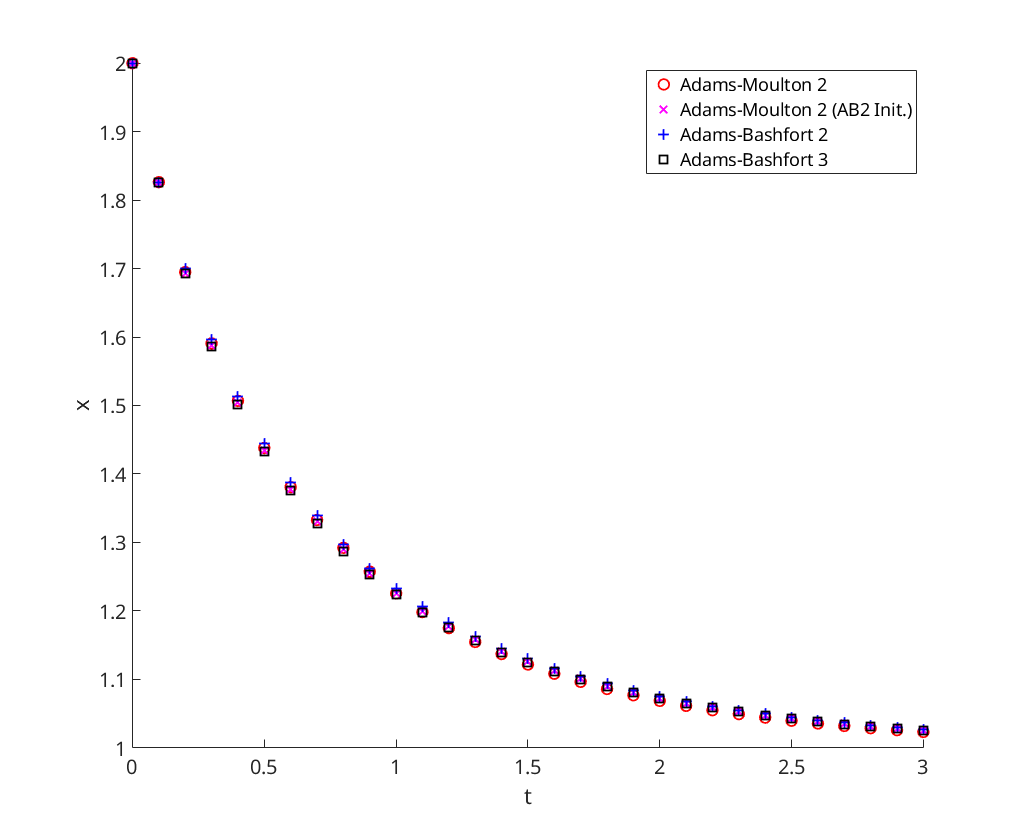
b) Linear Oscillator - Adams-Moulton 2-step
We solve linear oscillator with  ,
,  ,
,  ,
,  and
and  using Adams-Moulton 2, Adams-Moulton 2 with AB2 initial guess, Adams-Bashfort 2, and Adams-Bashfort 3
using Adams-Moulton 2, Adams-Moulton 2 with AB2 initial guess, Adams-Bashfort 2, and Adams-Bashfort 3
figure axis([0 10 -4 4]); hold on; xlabel('x_1'); ylabel('x_2'); [t,x]=am2(@oscillator,0,10, [2;1], .1); plot(t,x(:,1),'ro','DisplayName','Adams-Moulton 2'); [t,x]=am2_mod(@oscillator,0,10, [2;1], .1); plot(t,x(:,1),'mx','DisplayName','Adams-Moulton 2 (AB2 Init.)'); [t,x]=ab2(@oscillator,0,10, [2;1], .1); plot(t,x(:,1),'b+','DisplayName','Adams-Bashfort 2'); [t,x]=ab3(@oscillator,0,10, [2;1], .1); plot(t,x(:,1),'ks','DisplayName','Adams-Bashfort 3'); legend('Location', 'NorthEast');
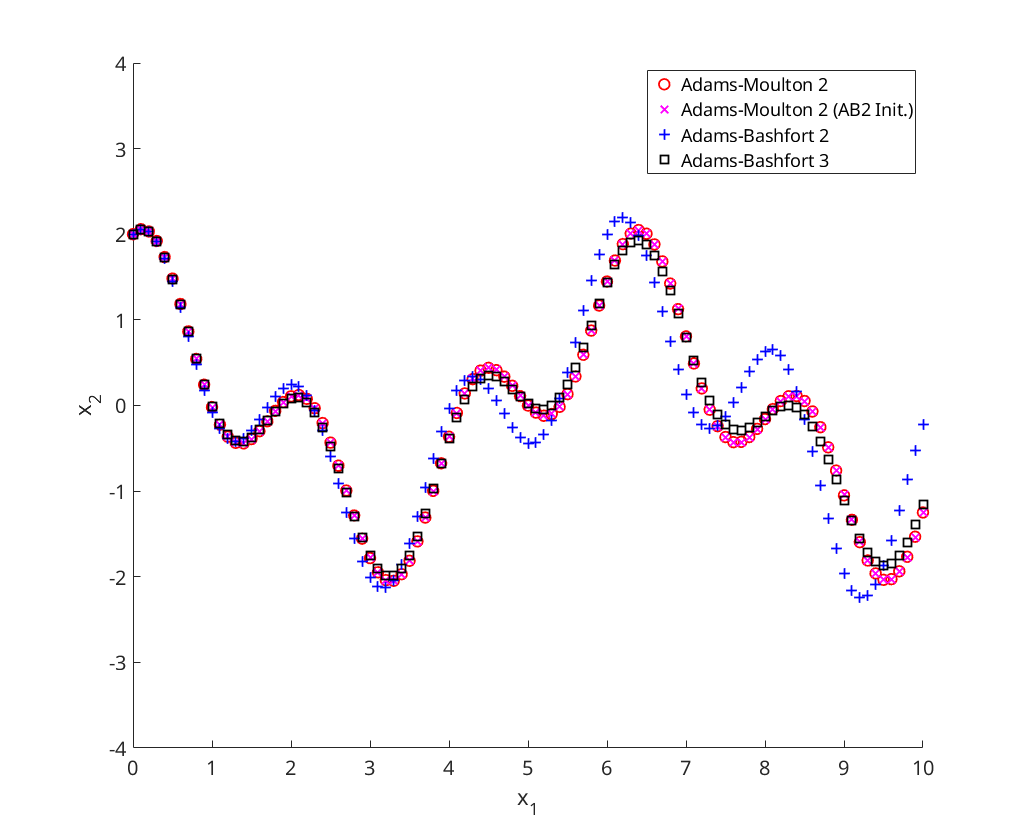
c) Linear System - Adams-Moulton 2-step
We solve the stiff linear system with  using Adams-Moulton 2, Adams-Moulton 2 with AB2 initial guess, Adams-Bashfort 2, and Adams-Bashfort 3
using Adams-Moulton 2, Adams-Moulton 2 with AB2 initial guess, Adams-Bashfort 2, and Adams-Bashfort 3
figure axis([0 10 -4 4]); hold on; xlabel('x_1'); ylabel('x_2'); [t,x]=am2(@linsystem,0,.1, [2;1], .001); plot(t,x(:,1),'ro','DisplayName','Adams-Moulton 2'); [t,x]=am2_mod(@linsystem,0,.1, [2;1], .001); plot(t,x(:,1),'mx','DisplayName','Adams-Moulton 2 (AB2 Init.)'); [t,x]=ab2(@linsystem,0,.1, [2;1], .001); plot(t,x(:,1),'b+','DisplayName','Adams-Bashfort 2'); [t,x]=ab3(@linsystem,0,.1, [2;1], .001); plot(t,x(:,1),'ks','DisplayName','Adams-Bashfort 3'); ylim([-5 15]); xlim([0 .12]); legend('Location', 'NorthEast');
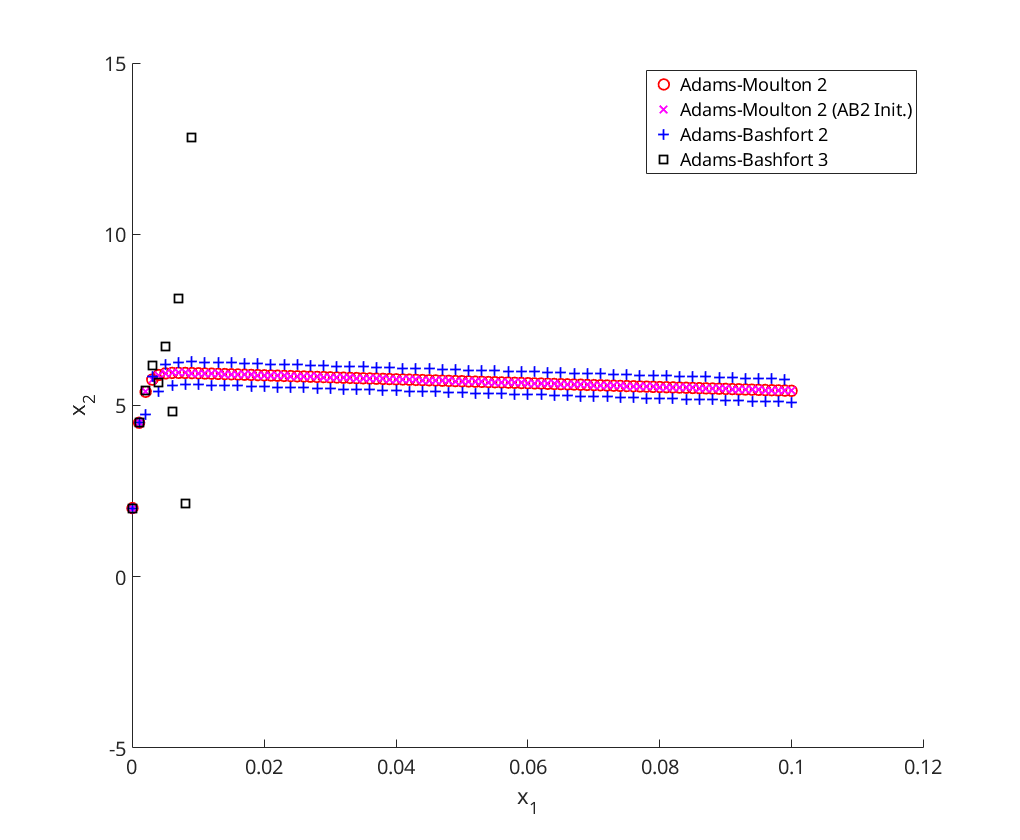
Convergence Analysis for Adams-Moulton
We perform convergence analysis for 2-step Adams-Moulton
fprintf('Adams-Moulton 2-step = '); conv_analysis(@am2); fprintf('Adams-Moulton 2-step (AB2 Init.) = '); conv_analysis(@am2_mod);
Adams-Moulton 2-step = log_{10}E_N = -1.757798 + 0.685327 x log10(h)
Adams-Moulton 2-step (AB2 Init.) = log_{10}E_N = -1.377970 + 2.807129 x log10(h)
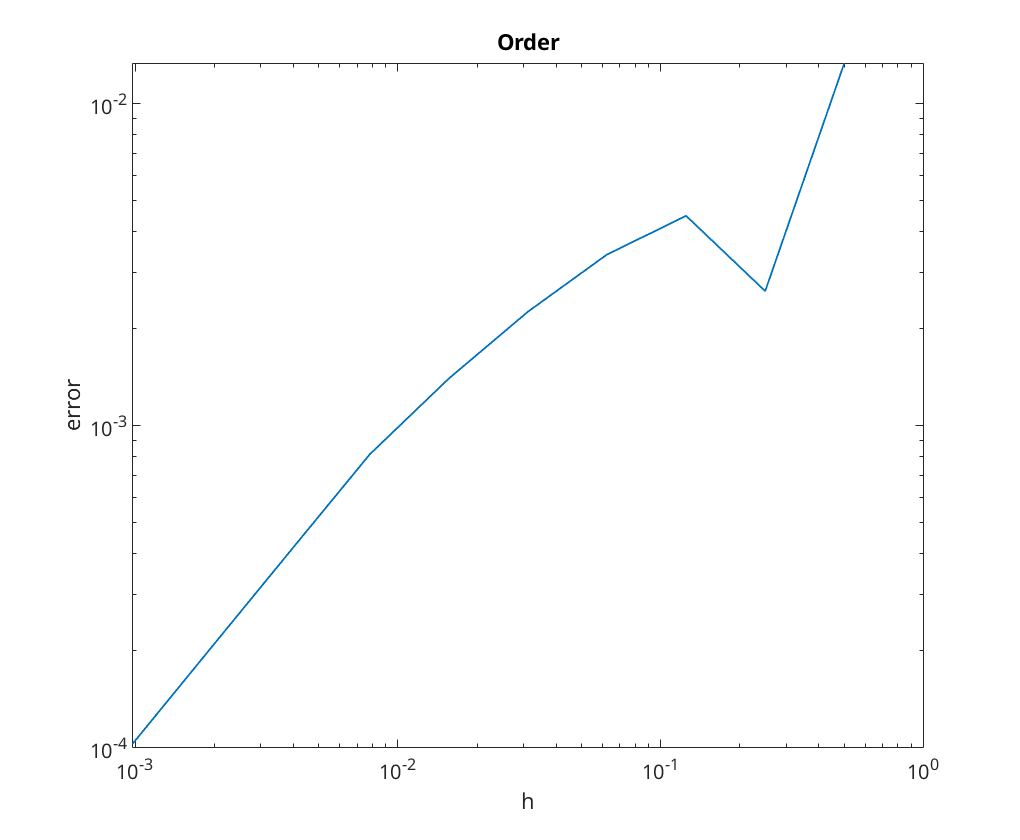
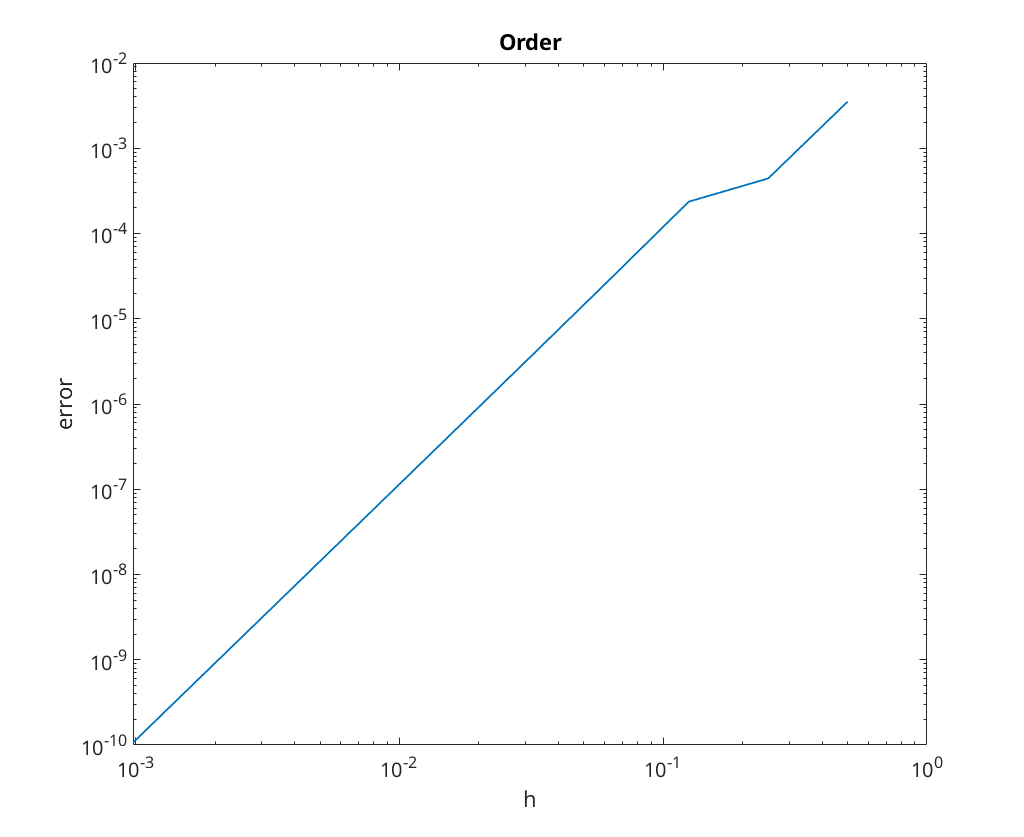
We perform convergence analysis for 2-step Adams-Moulton with various tolerances ( , ...,
, ...,  ) for the fixed point iteration
) for the fixed point iteration
Note: the following uses a modified version of conv_analysis which suppresses the output. This is purely for simplicity of the published output, so can be replaced by the normal conv_analysis
conv = zeros(7,2); conv(:,1) = 10.^(-2:-1:-8); figure; for i=1:size(conv,1) conv(i,2) = conv_analysis(@(field, t0, T, x0, h)... am2_tol(field, t0, T, x0, h, conv(i,1)), Output=0, NewFigure=0); hold on; end legend('tol=10^{-2}','tol=10^{-3}','tol=10^{-4}','tol=10^{-5}',... 'tol=10^{-6}','tol=10^{-7}','tol=10^{-7}',Location='SouthEast'); disp(array2table(conv,VariableNames={'Tolerance','Order of Convergence'}));
Tolerance Order of Convergence
_________ ____________________
0.01 0.514871250816776
0.001 0.561782413353
0.0001 1.35813085476437
1e-05 1.77360613967155
1e-06 2.05729238060897
1e-07 2.67281067051432
1e-08 3.08911231844274
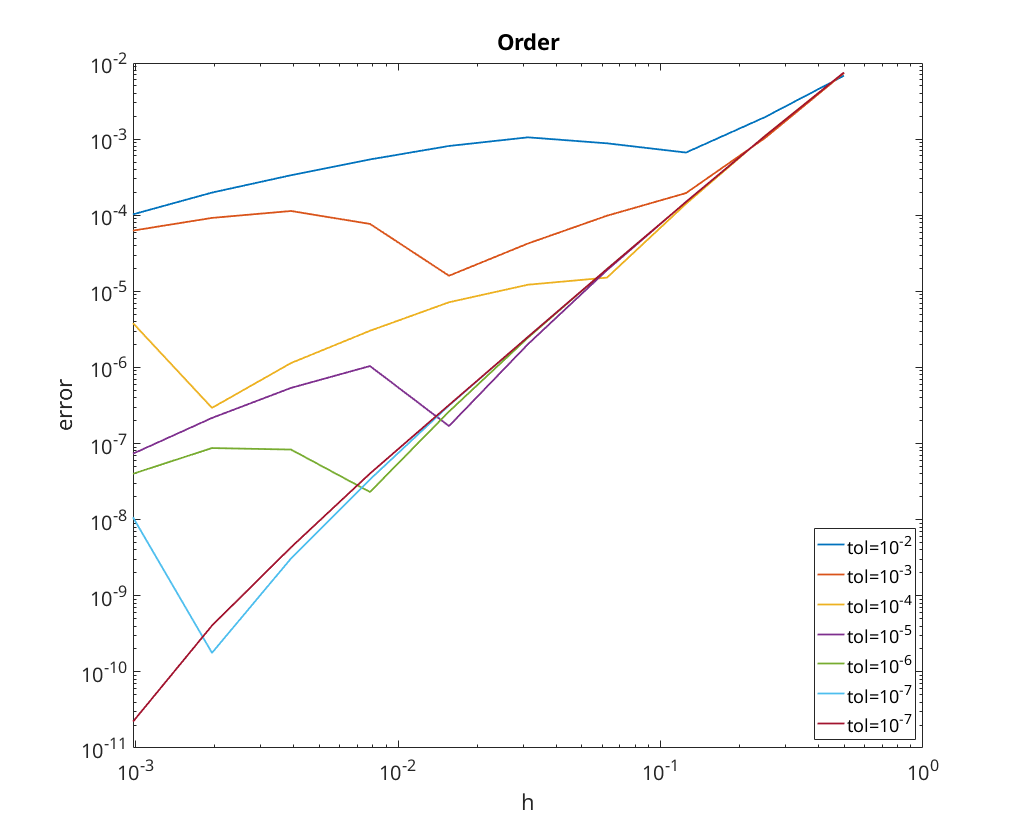
We notice that if the tolerance is too large it limits the rate of convergence due to the fact that as the step size decreases the convergence is limited by the tolerance as opposed to step size
end
Modified Adams-Moulton 2 to support passing tolerance as an argument
function [t,x] = am2_tol(field, t0, T, x0, h, tol) m = 2; n = ceil((T-t0)/h); t = t0+h*(0:n).'; x = ones(n+1,length(x0)); [t(1:m), x(1:m,:)] = rk_classical(field, t0, t0+(m-1)*h, x0, h); f0 = feval(field, t(m), x(m,:)'); f1 = feval(field, t(m-1), x(m-1,:).'); for i=m:n f_old = feval(field, t(i)+h, x(i,:).'); x(i+1,:) = x(i,:).' + h*(5*f_old+8*f0-f1)/12; f_new = feval(field, t(i)+h, x(i+1,:).'); while norm(f_old-f_new, 'inf') >= tol f_old = f_new; x(i+1,:) = x(i,:).' + h*(5*f_old+8*f0-f1)/12; f_new = feval(field, t(i)+h, x(i+1,:).'); end f1 = f0; f0 = f_new; end end